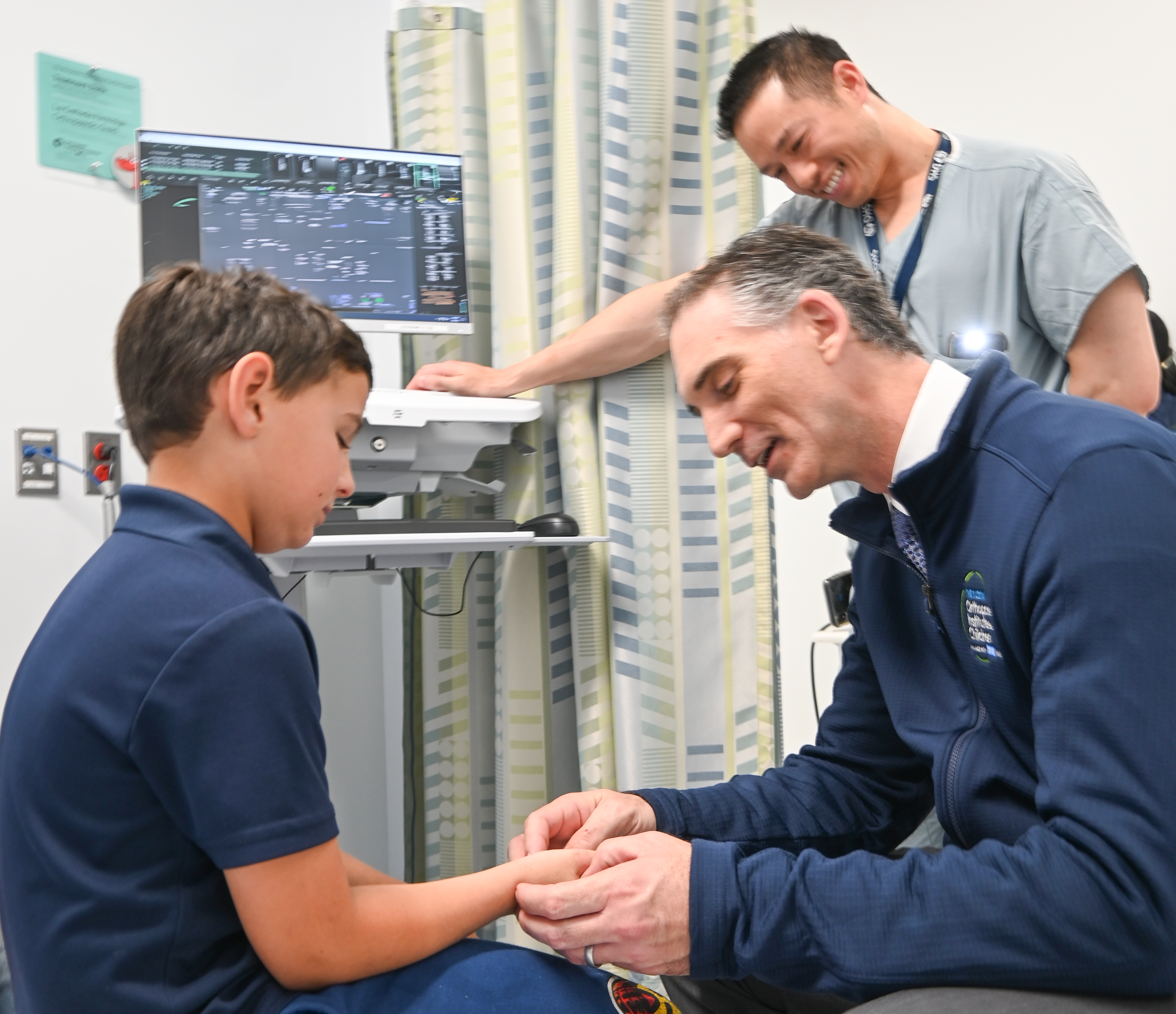HAND TRAUMA
If you suspect your child has had an injury to their hand, they should be seen right away. These types of injuries can affect how well your child can use their hands, and can have a negative impact on their everyday quality of life.
Call for an Appointment 213-742-1000
CONGENITAL DIFFERENCES AND MICROSURGERY
Our expert care treatment includes:
Pediatric hand and wrist injuries (link)
Congenital limb differences (link)
Microsurgical reconstruction of congenital and acquired bone, nerve, muscle and soft tissue deficiencies
Call for an Appointment 213-742-1000

Understanding Congenital Hand Differences in Kids
At LuskinOIC, your child will receive hand trauma treatment from award-winning doctors in pediatric orthopedics. Our state-of-the-art technology helps us treat our patients and get them on the path to living full and active lives.
Understanding Congenital Hand Differences in Kids
Approximately 1% to 2% of newborns are born with congenital differences, with 10% of these cases involving malformations in the hand. Congenital hand differences, or congenital hand disorders, can manifest early in pregnancy as the arms, hands, and fingers undergo development. Disruptions in this process, whether due to genetic syndromes, environmental factors, or interruptions during development, can lead to various congenital hand conditions. Additionally, issues with the hands or upper extremities may arise postnatally due to trauma or illness.
The impact of a hand malformation on a baby's life varies depending on its type and severity. While some infants may easily adapt and function normally, others may encounter challenges as they develop and learn, such as:
Developmental issues, such as delayed or impaired motor skills
Difficulties performing everyday tasks and basic self-care activities
Restrictions on certain physical activities and sports
Potential emotional and social repercussions due to teasing or stigma related to appearance
In cases where a child is functioning well and content, treatment may not be necessary. However, if a hand malformation impedes a child's desired activities, treatment options may be explored to address the challenges they face.
Choose a section you would like to review
Overview
Understanding Congenital Hand Differences in Kids
Approximately 1% to 2% of newborns are born with congenital differences, with 10% of these cases involving malformations in the hand. Congenital hand differences, or congenital hand disorders, can manifest early in pregnancy as the arms, hands, and fingers undergo development. Disruptions in this process, whether due to genetic syndromes, environmental factors, or interruptions during development, can lead to various congenital hand conditions. Additionally, issues with the hands or upper extremities may arise postnatally due to trauma or illness.
The impact of a hand malformation on a baby's life varies depending on its type and severity. While some infants may easily adapt and function normally, others may encounter challenges as they develop and learn, such as:
Developmental issues, such as delayed or impaired motor skills
Difficulties performing everyday tasks and basic self-care activities
Restrictions on certain physical activities and sports
Potential emotional and social repercussions due to teasing or stigma related to appearance
In cases where a child is functioning well and content, treatment may not be necessary. However, if a hand malformation impedes a child's desired activities, treatment options may be explored to address the challenges they face.
Types
Types of Congenital Hand Differences in Kids
Sometimes, differences or anomalies in hand and finger development in children occur inexplicably. Among the most prevalent of these birth defects are:
Extra Digits (Polydactyly) Polydactyly is the most common congenital hand anomaly, affecting both boys and girls without bias. Infants born with polydactyly present with more than the standard five fingers on a single hand. Typically, the additional digit consists of soft tissue and can be easily removed. In some instances, the extra finger may possess bones but lack joints, while exceptionally rare cases see a fully functional digit emerge. Occasionally, a baby may exhibit multiple extra fingers.
Various types of polydactyly exist:
Preaxial polydactyly: Characterized by the presence of an additional thumb, this form is more common among Caucasians. Pediatric surgeons typically perform removal of surplus bone and tissue, along with bone curvature correction and possible tendon repair.
Postaxial polydactyly: Here, extra fingers emerge on the opposite side, commonly known as the "pinky" side, and are more prevalent among African-Americans. These additional digits may appear as complete, separate fingers or mere stumps (called “nubbins”), which can be addressed by a hand specialist in an outpatient setting.
Central polydactyly: Less common, this variation entails extra fingers positioned between the central digits.
Fused Fingers (Syndactyly) Syndactyly emerges as one of the prevailing birth abnormalities of the upper limbs, affecting approximately 1 in every 2,000 live births. This condition arises when two or more fingers fail to separate during fetal development, resulting in "webbed" fingers upon birth, typically involving the middle and ring fingers.
Boys are afflicted with syndactyly at twice the rate of girls, often with a familial predisposition that extends to both fingers and toes.
Surgical intervention is commonly necessary before the child reaches 18 months of age to separate the fused digits, sometimes requiring additional skin grafting from another area of the body, depending on the extent of fusion.
Syndactyly is categorized into several types:
Complete syndactyly: In this form, the skin is fused entirely to the tips of the affected fingers or toes
Incomplete syndactyly: Here, the fusion of fingers or toes is partial, extending only part of the way towards the tips
Simple syndactyly: Fusion occurs solely through skin and soft tissue
Complex syndactyly: This type involves fusion of the bones of adjacent fingers
Underdeveloped Hand (Symbrachydactyly) Symbrachydactyly presents in newborns with either diminutive or absent fingers, often accompanied by webbing between the digits or a shortened hand or forearm. It can also be seen with Poland syndrome, a condition characterized by the absence of a portion of, or all of, the pectoral muscles on one side of the body.
Symbrachydactyly can be categorized into the following types:
Mild symbrachydactyly: The hand typically exhibits slightly shortened yet mobile fingers with minimal webbing. The hand bones and some of the finger bones and the thumb are present.
Moderate symbrachydactyly: manifests with the absence of most or all finger bones, replaced by small projections of skin and soft tissue. Though the thumb is usually present, it may appear shortened.
Severe symbrachydactyly: denotes either a partial or complete absence of the thumb and all fingers.
Patients with one of these diagnoses may be treated with deepening of web spaces, while others may be candidates for microsurgical transplantation of one or more toes to the hand to improve hand function.
Club Hand Children born with club hand often exhibit a partial or complete absence of one of the two forearm long bones—the radius or the ulna. Consequently, the affected forearm may appear shorter than typical, with the hand turning inward, restricting wrist mobility. Such limitations can hinder the child's ability to perform manual tasks.
The prominence of the condition tends to favor one side of the hand—the radial (thumb) side or the ulnar (little finger) side:
Radial club hand, also known as radial dysplasia, typically presents with a shortened forearm and a wrist that curves toward the thumb side. Surgery may be recommended to straighten the forearm bone and correct tendon issues. Additionally, radial club hand may be associated with medical syndromes such as Fanconi anemia, Holt-Oram syndrome, and VATER syndrome.
Ulnar club hand, though less common than its radial counterpart, often occurs independently of other syndromes. Its severity can vary, ranging from mild to severe cases where the wrist remains fixed and bent towards the little-finger side of the hand.
Cleft Hand (Ectrodactyly) Cleft hand, also known as ectrodactyly or split hand, occurs when the central portion of the hand develops abnormally, resulting in the absence of one or more central fingers in affected babies.
There are typically two types of this condition:
Typical cleft hand: This variant presents as V-shaped and commonly involves the partial or complete absence of the middle fingers. Both hands are frequently affected, and in some cases, the condition may extend to the feet as well. A familial history of typical cleft hand is often observed.
Atypical cleft hand: Manifesting as U-shaped, this type typically affects only one hand and is less commonly inherited. Atypical cleft hand may be indicative of Poland syndrome, a condition characterized by the absence of chest muscles on one side of the body, among other symptoms.
Small Thumbs (Hypoplastic) A hypoplastic thumb, either incompletely formed during fetal development or entirely absent at birth, requires treatment tailored to the stability of the joint connecting the thumb's base to the wrist.
Children with stable joints typically incorporate their thumbs into everyday play activities. Conversely, those with unstable joints often tend to disregard their thumbs.
In cases where the thumb-wrist joint is stable, reconstructive surgery is typically advised to enhance the thumb's structure and its associated tendons. However, when dealing with loose or unstable joints, surgical intervention may involve rebuilding the thumb joint and transferring a tendon to improve the thumb’s ability to oppose the other fingers. In severe cases of thumb instability, removal of the underdeveloped thumb and conversion of the index finger into a functional thumb, a procedure called pollicization, may be indicated and can significantly improve their overall hand function.
Trigger Thumb Occasionally, infants and toddlers can develop a thickening of the tendon for thumb flexion, leading to difficulty in bending it. In some cases, this condition resolves spontaneously around the age of three. However, if the issue persists, surgical intervention may be advised before the child reaches three years old to release the tendon and restore proper thumb functionality.
Diagnosis
Diagnosing Congenital Hand Differences in Children
Congenital hand differences are frequently diagnosed through prenatal ultrasound examinations, which utilize sound waves to generate images of the fetus during pregnancy. At LuskinOIC, doctors also conduct postnatal assessments immediately after birth to identify any hand abnormalities.
The formation of a baby's arms and hands occurs between the fourth and eighth weeks of pregnancy. Disruptions during this critical period can result in congenital hand deformities, such as incomplete development of body parts or syndactyly, where hand structures fail to separate properly.
The precise cause of many hand deformities remains unknown, making prevention challenging. While treatment cannot commence until after birth, an early diagnosis enables parents to prepare for necessary interventions. Our physicians offer prenatal consultations to assist families in planning for treatment, which typically commences during the early years of the child's life.
Evaluation of hand deformities involves a comprehensive physical examination by an orthopedist, assessing the shape, mobility, and functionality of the hand, fingers, wrist, and forearm. Associated deformities in the opposite hand, legs, and spine may also be examined, with additional specialist consultations sought if necessary.
X-rays play a crucial role in diagnosis, revealing any missing, shortened, or fused bones in the hand or arm. Comparison X-rays of the opposite hand aid in assessment, while imaging of the legs and spine may be necessary to identify associated abnormalities common in certain conditions.
Treatment
Treatment for Children with Congenital Differences
Every child with a congenital hand difference is unique and treatment is based on each child’s individual needs. The primary objective and benefit of treatment are centered on enhancing the child's functional capacity with their hand difference. Additionally, the aim is to enhance the appearance of the affected hand, improving the child's self-esteem and confidence.
Options for treating congenital hand differences include:
Stretching
Splinting or casting
Physical therapy to help increase strength and function
Surgery
Our Experts

Timothy Schaub, MD
Timothy Schaub, MD

Joan Wright, MD
Joan Wright, MD

Annie Tashjian, PNP
Annie Tashjian, PNP

Plan Your Visit
From bringing the right paperwork to driving directions, find out what you need to know for your visit.